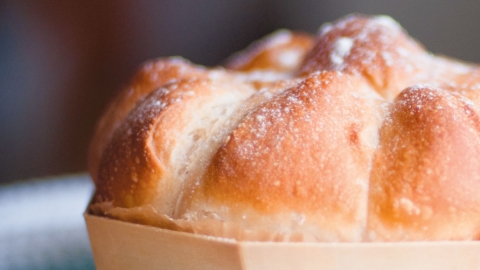Ingredients
- ½ teaspoon active dry yeast
- 4 ounces warm water
- 2 ounces whole wheat flour
- 2 ounces kamut flour
- 1 ounce amaranth
- 2½ cold water
- 1 teaspoon active dry yeast
- 2 teaspoons table salt
- 1¾ ounces warm water
- 8 ounces whole wheat flour, preferably organic
- 6 ounces unbleached bread flour
- 2 ounces millet flour
- 8 ounces cool water
- 8 ounces poolish (above)
- 3½ ounces soaker (above)
- Vegetable oil
Instructions
Poolish
Measure and weigh Measure the yeast and set it aside.
Weigh the warm water into a small bowl. The warm water should feel hot to the touch, between 105° and 115°. Sprinkle the yeast on top of the water, stir to dissolve, and set aside.
Weigh the whole wheat and the kamut flours and combine in a bowl, stir to mix together, then make a well in the center.
Mix Add the yeast mixture to the flour, and stir 3 or 4 turns, until all of the ingredients are incorporated. If your poolish seems dry, add ½ to 1 more ounce of water.
Cover the bowl with plastic wrap and allow to ferment at room temperature for 2½ to 3 hours.
Remember, a poolish needs time to ferment before you can proceed with the dough, anywhere from 2½ to 3 hours at room temperature.
This particular poolish should be used immediately after it has doubled in volume, after 2½ to 3 hours, and not be held in the refrigerator overnight, due to the vulnerable nature of the flours and their lack of protein and gluten strength.
Soaker
Make the soaker Weigh the amaranth and the cold water into a small saucepan with a lid. Bring to a boil, then lower the heat and simmer for 20 to 25 minutes, until all water has been absorbed. Put the mixture in a small bowl and let it cool completely before adding it to the dough.
Whole Wheat Bread
Measure and weigh Measure the yeast and the salt separately and set them aside.
Weigh the warm water into a small bowl. The warm water should feel hot to the touch, between 105° and 115°. Sprinkle the yeast on top of the water, stir to dissolve, and set aside.
Weigh the wheat flour, bread flour, and millet flour, combine them in a large bowl, and mix together. Then sprinkle the salt on top of the flours, stir to incorporate, and make a well in the center.
Weigh the cool water into a bowl.
Mix First, combine the poolish and the soaker with the cool water, using your fingers to help break up the poolish to dissolve. Add the yeast mixture to the flour, stir 3 or 4 turns, and then, little by little, add the cool water with the poolish and the soaker. Mix with your hands for 2 to 3 minutes, until all of the ingredients are incorporated, the grit of the salt is dissolved, and the dough forms a rough and shaggy mass, and then stop.
Let the dough rest Cover the bowl with a kitchen towel or plastic wrap and let the dough stand still for about 30 minutes.
Fold Sprinkle your work surface with flour and then use a plastic bowl scraper to scrape the dough out onto it. Tap your hands in a little flour, then gently flatten the dough into a rectangle, with the short side facing you.
Use your fingers or the plastic scraper to flip the top edge of the dough down to just below the center, then flip the bottom edge up to just above the center. Repeat this process for the right and left sides, then turn the dough over and dust off the flour.
Ferment Oil a second large bowl, then place the dough in it, seam side up, to oil the top. Then turn it seam side down, and cover the bowl with oiled plastic wrap. Mark the time with a felt-tipped pen on the plastic wrap and allow the dough to rest and rise in a moderately cool place until it has doubled in volume, 1 to 2 hours, depending on the heat of your environment.
After the first 30 minutes of fermentation, turn the dough out of the bowl onto your work surface, and fold a second time as described above. Return the dough to the bowl, cover, and complete the fermentation.
Folding a second time will help strengthen the dough, necessary because this dough contains one flour that has no gluten.
Pre-shape and shape Once the dough has doubled in volume, sprinkle a little more flour onto your work surface, then scrape the dough out onto it, letting the dough assume its natural shape. Tap your hands in flour, and gently flatten the dough, then divide into 2 equal pieces.
Pre-shape each dough piece into a log. Shape each log into a baguette, then shape each baguette into a tight coil, with all sides touching, and place the coils on an oiled baking sheet at least 3 or 4 inches apart.
Proof Cover the dough with oiled plastic wrap and let proof for 30 to 45 minutes, or just until it is almost doubled in volume.
While the dough is proofing, preheat the oven to 480°, with an empty pan for creating steam on the bottom of the oven. Have ready a spritzer filled with water near the oven and approximately 8 ounces of hot water to pour into the empty pan.
Bake Open the oven door, and, working quickly, slide the pan with the coils onto the middle rack, then pour the hot water into the empty pan below to create steam before quickly closing the oven door. After 1 minute, open the oven door and spritz around the dough with water, then close the door again.
The bread should bake to a rich brown color in 35 to 45 minutes.
Cool When the bread has finished baking, let it cool completely on a wire rack.
Yields 38 ounces dough; 2 spiral-shaped loaves
Excerpt from One Dough, Ten Breads: Making Great Bread by Hand
Related shaping instructions
Adapted and abridged for the purposes of this excerpt
Pre-Shaping a Log
To pre-shape the dough into logs, take the dough, flatten it into a rectangle, and position the rectangle so that the short end faces you. Using both hands, pick up the top edge and pull it past the center of the dough, press it so it adheres to itself, then do the same with the bottom edge. Repeat this action with the top piece only and press the dough together firmly to make a tight log.
Shaping a Baguette
Sprinkle just a bit more flour on the counter, then take one log and position it lengthwise in front of you with the bottom seam facing up.
Begin by folding the dough in half, using the heel of your hand to make an imprint of the crease before folding. Starting from the upper right tip of the dough, pull and stretch the dough over and down between the thumb and fingers of your left hand, then seal it with the bottom of the palm of your right hand. Continue this process all the way down the length of the baguette. Your right palm should be held upright, like waving, so it does not flatten and compress the dough. Repeat this process once or even twice more, until the baguette is approximately 1½ inches wide.
Set the baguette aside, covered with oiled plastic wrap, and repeat the process with the remaining piece of dough. Let the dough rest, covered, for another 8 to 10 minutes.
After the dough has rested, elongate the baguettes on a very lightly floured counter: Place 1 baguette in front of you, lengthwise. Use both hands, with your fingers together, to roll the baguette back and forth, starting in the center and then moving your hands apart and tapering the edges until the baguette is 12 to 14 inches long. Repeat with the second baguette.










